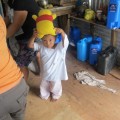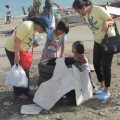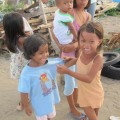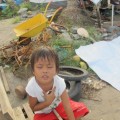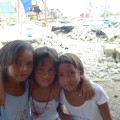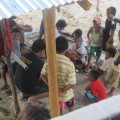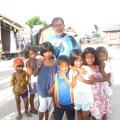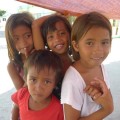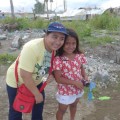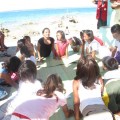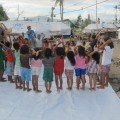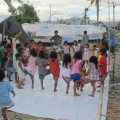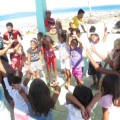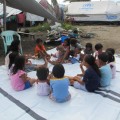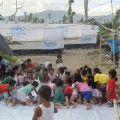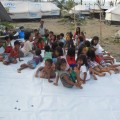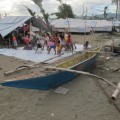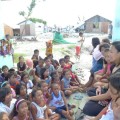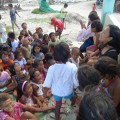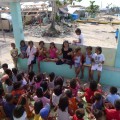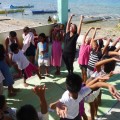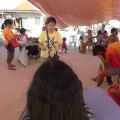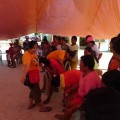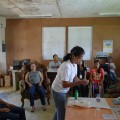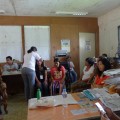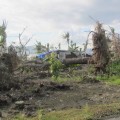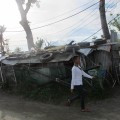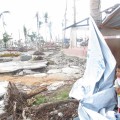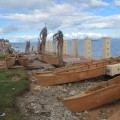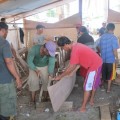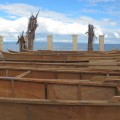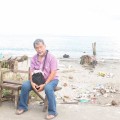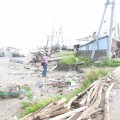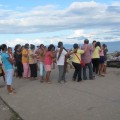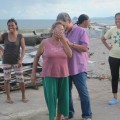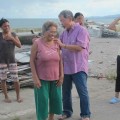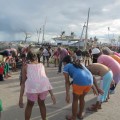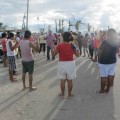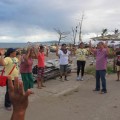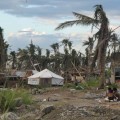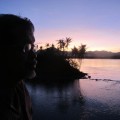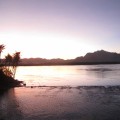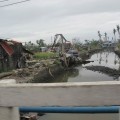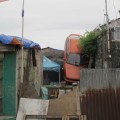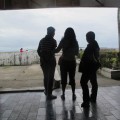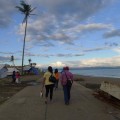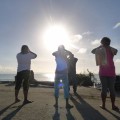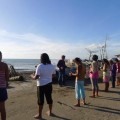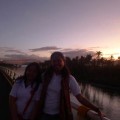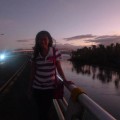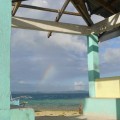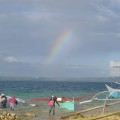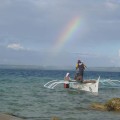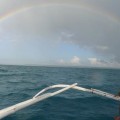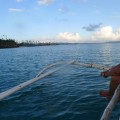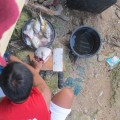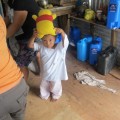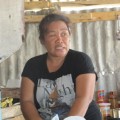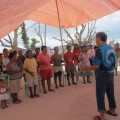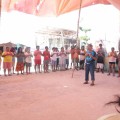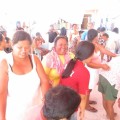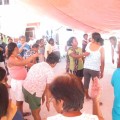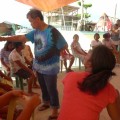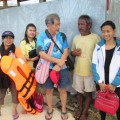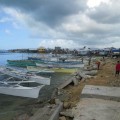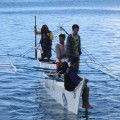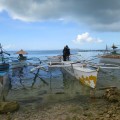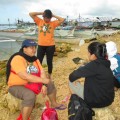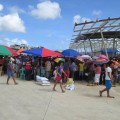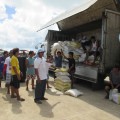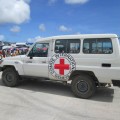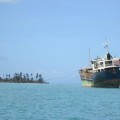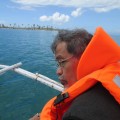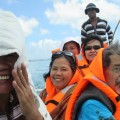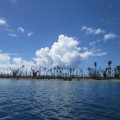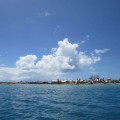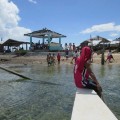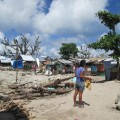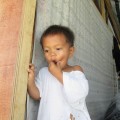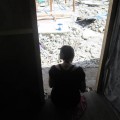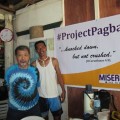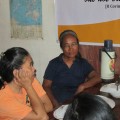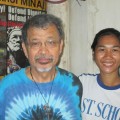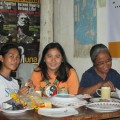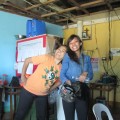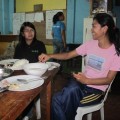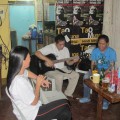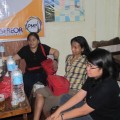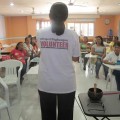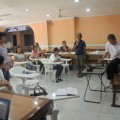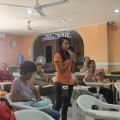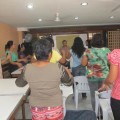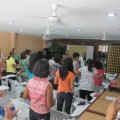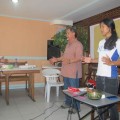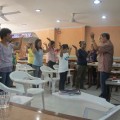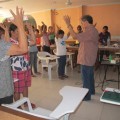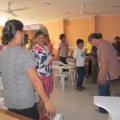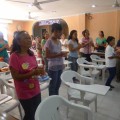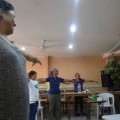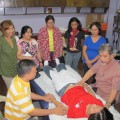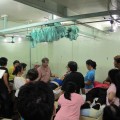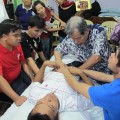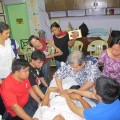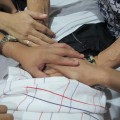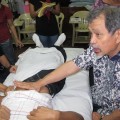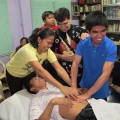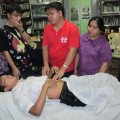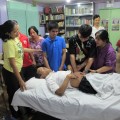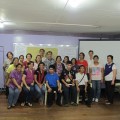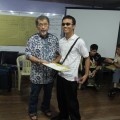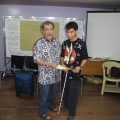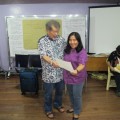Author: renejnavarro
Yoga and Sonia
Sonia Astudillo led the kids in yoga.
Victory Island and Tacloban City: acupuncture
Tacloban City: Barangay 89-90
At the fishermen’s cove, there were no boats. A crew was building new ones from plywood at a steady pace under a tent. We were told that we were going to meet the women down the road. Most everybody was living in tents and makeshift huts. There were children playing. Sonia taught them yoga on a tarp because there was no space for it anywhere. I taught qigong and massage on part of the road that had not collapsed under the waves. As I surveyed the scene of destruction, somebody who had my camera took shots of me as I walked around and then sat. Soon, women were coming for qigong lessons. The next day, at 7 am, we resumed the class at sunrise.
Annie, MariCris, Ric and I walking on the remnant of a road in Barangay 89-90 that had been washed away by Yolanda. Our group of 5 had grown by one: Ric, an INAM staffer, joined us for a couple of days in Tacloban City. He had studied with me for 10 years, so did Annie. I had taught them Tai chi, Qigong, massage, Microcosmic Orbit and acupuncture. I am confident in their abilities to share what they have learned, not only from me but also from others. They are excellent healers, as much dedicated to the healing arts as they are to the Filipinos. They have traveled the islands to teach and to heal even in the remotest areas of the country. In a farewell to the area demolished by the typhoon, we went to the San Juanico Bridge connecting Leyte and Samar. The sun was setting. Annie snapped a few shots of Sonia and me. Sonia took a photo of Annie and Ellen. MariCris had gone ahead of us to the airport: she had a conference to attend in Manila. A busy week ahead: a conference on acupuncture curriculum, another with the Dumagats, a Tai chi class, a summing up and assessment of our work in the field and then, for me, a long journey back to Easton, Pennsylvania.
Leaving Victory Island: A Rare Double Rainbow
As we were departing, a rainbow showed up beyond the beach. The shots were taken by Sonia. I took several shots but my camera failed to capture the rainbow. At sea, a gentle rain fell on us. It reminded me of the rains in Bali or Hawaii: soft and short like a blessing from the sky.
Victory Island
En Route to Victory Island
The sea was the bluest blue, and calm. Still, we had anxiety about the sudden change in the weather. We can trust the sea, but I have had the experience of sudden squalls and rains in Coron, Palawan just a year ago. We were welcomed by children who were taking lessons in drawing. They were waving their art work when we arrived. The boy was in the house where we had lunch of boiled squid, chicken adobo and fish soup. That’s Sonia sitting on the top of the stairs surveying the scene of destruction and children playing basketball with a tennis ball and a goal put together with a wire for a goal and pieces of lumber for a backboard.
Guiuan, Eastern Samar
We taught a combination of qigong and massage. Women from different islands in Eastern Samar attended. We listened to their stories. A 16-year old, encouraged by her mother, talked about her experiences.
The restaurant was one of the buildings spared by the typhoon. There was a sound system, chairs, toilet facilities and air-conditioning. We had one class here. About 40 women from different islands attended.
February 2014 – Manila
Dear Friends,
The geographic trajectory of my recent journey to the islands of Leyte and Eastern Samar in Central Philippines is easy to follow: a flight on Sunday afternoon February 2 from Manila south to Tacloban City, Leyte, one of the most devastated areas in the country. On arriving at the airport in Tacloban City, we took a rental van past the famous San Juanico Bridge to Guiuan, a town in Eastern Samar. It was a 3-hour journey through beautiful but desolate landscape, the sea and islands to the right, mountains to the left, and coconut boles that had lost their fruits and leaves dotting the scene. The last hour of the trip at sunset was over pitted and cratered roads, a white-knuckle route made scarier by a race-car wannabe for a driver, tricycles (motorbikes with a sidecar, which are called tuktuks in Thailand and cyclos in Vietnam) and chickens and dogs and people crossing our path in the darkness.
From what I have seen, the destruction – physical, material, psychological and spiritual – was unimaginable. Photos can suggest but not capture the extent and depth of it or its direction. How do you draw a map of psychic damage and injury? We were speechless as we passed tent cities, corrugated iron shanties, heaps of garbage and debris, steel and wooden frames bent like match sticks, posts snapped
in two, uprooted trees, cars sitting on top of rooftops, endless assortment of detritus. I haven’t seen anything like it in my 73 years on the planet. Estimates could be drawn for the wreckage of buildings and assets, but who can arrive at the cost to the human psyche? How about the damage to the children?
From Guiuan, Eastern Samar, we rented and crowded into a small pump boat to take us to Victory Island 45 minutes away on a calm blue sea. “We” refers to Annie, Ellen, MariCris, Sonia and me. Annie, Ellen and MariCris are INAM Philippines staff and acupuncturists. They did acupuncture. I, an INAM consultant and visiting professor, led qigong and massage exercises. Sonia, a yoga teacher and raw food chef and a volunteer, taught basic yoga to the children. INAM organized the February mission after a first one in January.
When, on a bathroom break between Tacloban City, Leyte and Guiuan, Eastern Samar, I asked a storekeeper if she had bananas to sell, she said they had all been blown away by the wind. The reconstruction is going to take years. Five years is the minimum period before the coconuts bear fruits again, if at all. Meantime, where will the people find the food to eat? It takes about 6 months for rice to be harvested. Vegetables take at least a month, pigs and chickens at least 2 – 3 months. The land has been salted over by the sea – will that be a problem to agriculture? International and local rescue and relief operations are ongoing. The recovery has already started. We saw a group of fishermen building boats at Barangay 89-90 in Tacloban City. But how long will it take just to clear the debris and heal the people of the trauma from the typhoon? Haiyan (called Yolanda in the Philippines it possibly means sea – hai — voice — yan — ) packed 190-mile winds for several days. Somebody described the experience as like being in a giant washing machine: getting churned this way in the beginning and that way next, and then being squeezed and turned the other way, and then being washed again and again with the repeat cycle on. Well, add the vicious and relentless winds to the mix. The picture reminded me of the senseless suffering of an innocent child. Why? How do you explain the existence of such existential horror? All it suggested was not only the indifferent universe of Camus (in the Plague) and Dostoyevsky (in Brothers Karamasov) but an angry and merciless god or the trial of Job in the Old Testament.
The horror recalled an early childhood time back in the mid-1940s when a typhoon broke. My family and I (father, mother and 2 children) lived in a 10 feet x 10 feet one-story house standing a foot above the ground in my hometown of Bamban, Tarlac. The wind blew and whistled for hours. Afraid we would be drowned, an uncle “evacuated” us to his house next door that had a second floor and was definitely more solid than where we lived. The memory has remained with me until now.
We stopped for 2 nights at Guiuan to teach and share Qigong, meditation and massage techniques. You’ll probably not see our next stop, Victory Island, on the map because it is just a dot in the sea. Go now, said an area resident, while it is still there. The unpredictability of the weather made us anxious: in the region people talked about the amihan or the habagat, winds that descended even during calm days and nights. There was also a tropical depression the day before we departed Manila, strong enough to be called a typhoon; luckily, it left just when we arrived in Tacloban City.
At a session in Guiuan, we listened to the women who arrived in boats from different islands. We heard about their fears and nightmares when there is a strong wind or news of another storm, what triggers their fright and sense of helplessness. Encouraged by her mother, a 16-year old girl stood up and told the gathering about her vulnerabilities and worries. She was advised by her doctor to see a psychologist. The stories were so horrendous a group of acupuncturists who came earlier reportedly had to have treatments from a psychologist because they were themselves traumatized and were haunted by “ghosts.” One question I have often asked myself, How can you relieve human suffering with an acupuncture needle? I know there are acupoints that are effective for stress, for relaxation, but how do you get people to eventually help themselves and find peace and quiet and courage and leave that painful period behind?
My own humble approach is, in addition to acupuncture, to teach Qigong, empowerment, tuina/massage, protection and meditation techniques not only to the victims but also to healers. We named the protocol “INAM TaoRen Therapi,” part of the development of a Philippine approach to healing called integratib Medisin. We combined different acupuncture points – Kiiko’s Triple Intestine near the elbow, CV 6, GV 20, LI 4, LV 3, and a few others on the extremities. The Qigong and Tuina, involving massage, sounds and visualization included activating the Jing/Well points of the hands and certain areas of the body – Lung Mu, Stomach Mu, back of the knees, Zu San Li, the Gall Bladder line — and covered the sacrum, lumbar, shoulders and spine. The massage techniques are important because they are an essential link of human connectedness. Touching, a simple gesture, is a way of reaching out. The protocol is not a complete solution, far from it in fact, but it is what we can offer for now. Eventually, the acupuncturists, the teachers and the healers (there are also psychologists there) will leave and the typhoon victim will have to fall back on her own resources … and face or exorcise her ghosts. Alone, perhaps in the middle of the night, an area resident will need accessible techniques to cope. Or, together the victims will have to support each other ultimately with methods of facing up to the traumas … methods of self-cultivation or nurturing the body, mind and spirit. So we advised them to make the practices an integral part of their lives and their culture. We trained them – I hope well enough for the short time we had — to be familiar with the methods so that they can do the practices as well as teach them to friends and relatives in their remote neighborhoods and villages. Parts of the armamentum are simple methods of breathing, healing sounds and colors, meditation, and movements of taoyin or qigong and massage to learn to let go, reestablish human connection and restore the spirit. Hopefully, the practices will provide some form of relief and strength now and closure later.
INAM Philippines is only one of the many different organizations providing healing
and therapy to the population. The INAM staff is planning to return in March. I will join them in Guiuan, Eastern Samar and Tacloban City, Leyte, and the farther island of Homonhon in early August.
Thank you for your help.
Love and Blessings from the Philippines!
Rene
PS:
I don’t have a Twitter or Facebook account. If you have the time, look up the website of INAM Philippines for more photos of the mission. Sonya Astudillo, the yoga teacher, also has photos on her facebook page. So does Maria Cristina Parungao, the INAM director.
Gallery: Chi Nei Tsang internal organs massage seminar
Chi Nei Tsang internal organs massage seminar sponsored by INAM Philippines, an NGO that services
the disadvantaged population of the country. There were 8 blind/visually impaired masseurs, 7 women from Bulacan (fisherfolk), 5 acupuncturists, and several laypeople who are interested in healing and self-development. It was a 2-day seminar (from 8 to 6).
One time, I was teaching a qigong movement with the hand. I said, Start from 12 o’clock, move to 3 and then 6, up to 9 and back to 12. I realized later on, when I got a feedback, that the blind have not seen a clock, they have no idea of how it looks. They perceive time in terms of movement and light, the chirping of the birds, and the humming of the earth.
So when I taught an abdominal manipulation I asked them to put their hands over mine. What an experience!
